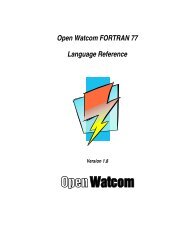Relocatable Object Module Format (OMF) Specification
Relocatable Object Module Format (OMF) Specification
Relocatable Object Module Format (OMF) Specification
You also want an ePaper? Increase the reach of your titles
YUMPU automatically turns print PDFs into web optimized ePapers that Google loves.
Tool Interface Standards<br />
<strong>OMF</strong>: <strong>Relocatable</strong> <strong>Object</strong> <strong>Module</strong> <strong>Format</strong>, Version 1.1<br />
The <strong>Relocatable</strong> <strong>Object</strong> <strong>Module</strong> <strong>Format</strong> <strong>Specification</strong>, Version 1.1, is the result of the work of<br />
the Tool Interface Standards (TIS) Committee--an association of members of the microcomputer<br />
industry formed to work toward standardization of the software interfaces visible to development<br />
tools for 32-bit Intel Architecture operating environments. Such interfaces include object<br />
module formats, executable file formats, and debug record information and formats.<br />
The goal of the committee is to help streamline the software development process throughout the<br />
microcomputer industry, currently concentrating on 32-bit operating environments. To that end,<br />
the committee has developed specifications--some for file formats that are portable across<br />
leading industry operating systems, and others describing formats for 32-bit Windows operating<br />
systems. Originally distributed collectively as the TIS Portable <strong>Format</strong>s <strong>Specification</strong>s, Version<br />
1.1, these specifications are now separated and distributed individually.<br />
TIS Committee members include representatives from Absoft Corporation, Autodesk<br />
Corporation, Borland International Corporation, IBM Corporation, Intel Corporation, Lahey<br />
Corporation, Lotus Corporation, MetaWare Corporation, Microtec Research, Microsoft<br />
Corporation, Novell Corporation, The Santa Cruz Operation, and WATCOM International<br />
Corporation. PharLap Software Incorporated and Symantec Corporation also participated in the<br />
specification definition efforts.<br />
The <strong>Relocatable</strong> <strong>Object</strong> <strong>Module</strong> <strong>Format</strong> <strong>Specification</strong>, Version 1.1, is the latest deliverable of<br />
the TIS Committee. It is based on existing, proven formats in keeping with the TIS Committee's<br />
goal to adopt, and when necessary, extend existing standards rather than invent new ones.<br />
<strong>Relocatable</strong> <strong>Object</strong> <strong>Module</strong> <strong>Format</strong> <strong>Specification</strong> (<strong>OMF</strong>)<br />
This document represents the TIS <strong>OMF</strong> specification, the 32-bit <strong>Relocatable</strong> <strong>Object</strong> <strong>Module</strong><br />
<strong>Format</strong> standard. <strong>OMF</strong> is the official definition for the standard relocatable object module<br />
format (<strong>OMF</strong>) for 32-bit applications and tools for Intel Architectures. This document presents<br />
the heritage of the format with a focus on its current 32-bit aspects. It is published and<br />
controlled by the Tool Interface Standards (TIS) Committee, an open industry standards body,<br />
and will be revised as clarifications and technical information become available to the TIS<br />
Committee.<br />
This <strong>OMF</strong> represents the consolidation of different <strong>OMF</strong>s in use today into a single industry<br />
standard specification. The information included within this document has been compiled from<br />
the following documents: The MS-DOS Encyclopedia by Microsoft Press, the PharLap 386/Link<br />
Reference Manual, the Intel 8086 object module specification (Intel Technical <strong>Specification</strong><br />
121748-001), the IBM OS/2 16/32-bit <strong>Object</strong> <strong>Module</strong> <strong>Format</strong> (<strong>OMF</strong>) and Linear eXecutable<br />
<strong>Module</strong> <strong>Format</strong> (LX), Revision 7 (dated April 24, 1993), and internal Microsoft documents.
















